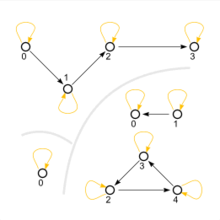Reflexive relation
The reflexivity of a two-digit relation 



A relation is called irreflexive if the relation 



Reflexivity is one of the conditions for an equivalence relation or an order relation; irreflexivity is one of the conditions for a strict order relation.

Three reflexive relations, represented as directed graphs
Formal definition
If 




Examples
Reflexive
- The less than or equal relation ≤
on the real numbers is reflexive, since always
holds. Moreover, it is a total order. The same holds for the relation ≥
.
- The ordinary equality
on the real numbers is reflexive, since always
holds. Moreover, it is an equivalence relation.
- The subset relation
between sets is reflexive, since always
holds. Moreover, it is a half-order.
Irreflexive
- The Kleiner relation
on the real numbers is irreflexive, since never
holds. Moreover, it is a strict total order. The same is true for the relation
.
- The inequality
on the real numbers is irreflexive, since never
holds.
- The real subset relation
between sets is irreflexive, since never
holds. Moreover, it is a strict half-order.
Neither reflexive nor irreflexive
The following relation on the set of real numbers is neither reflexive nor irreflexive:
Reason: For 



Search within the encyclopedia


